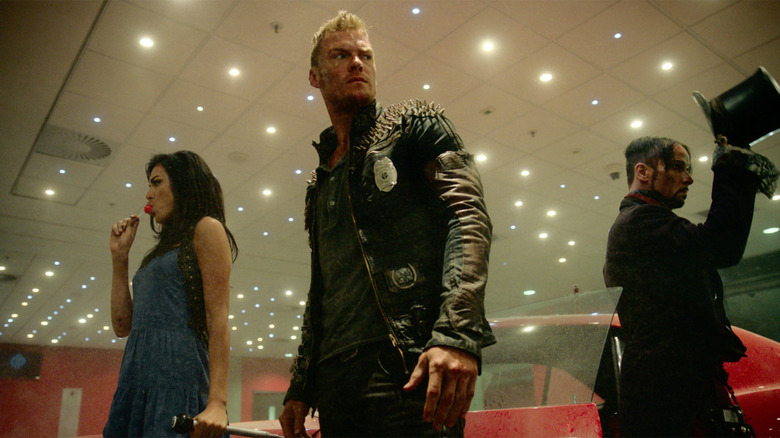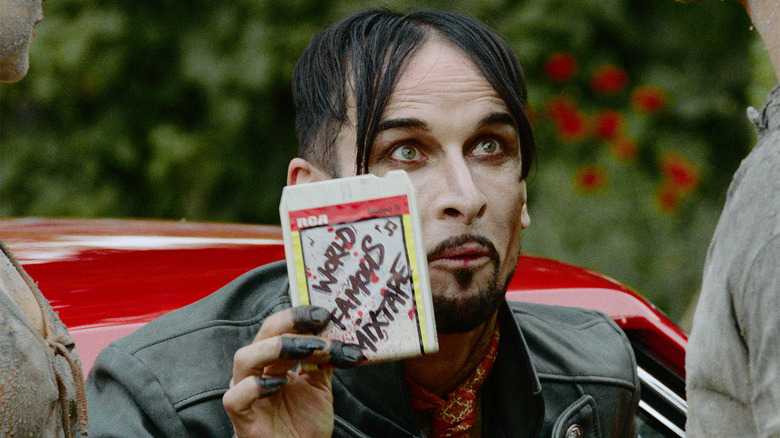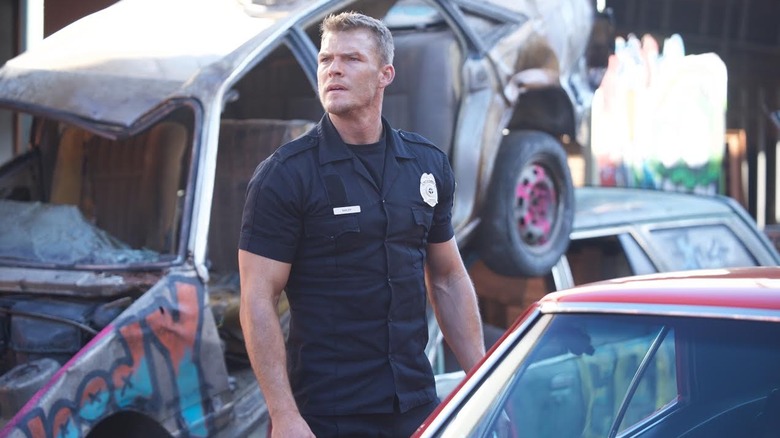Twisted Metal Has A Lot In Common With A Forgotten Alan Ritchson Sci-Fi Series
The second season of "Twisted Metal," based on the high-octane series of violent racing video games, debuted on Peacock on July 31, 2025. It takes place in a bleak, post-apocalyptic future wherein cities have fallen, and the roads are ruled by violent, charismatic gang leaders in tricked-out super-vehicles. Anthony Mackie plays the mysterious protagonist, known only as John Doe, a former milkman who suffers from amnesia. John Doe is tasked with making a mysterious delivery across the dangerous wasteland, leading him to butt heads with an evil clown named Sweet Tooth (bodily played by Joe Seanoa, voiced by Will Arnett) who drives a wicked ice cream truck.
The "Twisted Metal" game and the subsequent TV adaptation both take a lot of ideas and cultural cues from a generation of B-movies, most notably George Miller's "Mad Max" films. Miller's "Max" series popularized the notion of a car-based, desert-bound post-apocalypse in the popular imagination. The iconography of "The Road Warrior" is now part of the common cultural lexicon. The "Twisted Metal" TV series is based on a video game, but the game itself is derived from the aesthetics wrought by a generation of low-budget filmmakers, working with nothing but $500, a few old junkers, a fistful of TNT, and access to the bare highways of Australia.
That same B-movie aesthetic was also employed on a little-seen Syfy series from 2017 called "Blood Drive," easily one of the best TV shows the network has ever produced. "Blood Drive" only ran for 13 episodes, and isn't terribly well-remembered to this day, but it's one of the better horror TV shows of the last decade and definitely deserves attention. If you're a fan of "Twisted Metal," prepare to have your mind blown. It's "Twisted Metal" via "Grindhouse," but with the sex and gore ratcheted up to insane levels. It's awesome.
Blood Drive was wild and kooky and featured blood-drinking cars
The premise of "Blood Drive" was truly unusual. It took place in an alternate version of 1999, where the world had already been ruined by a series of devastating earthquakes. Water is rare, and gas is even rarer, so humanity has invented cars that run on human blood. Drivers can regularly be seen kidnapping hapless bystanders, popping their hoods, and feeding them kicking and screaming into the grinding, blood-hungry engines beneath. This future is overseen by an evil corporation called Heart Enterprises, which hosts an annual cross-country death race, the winner of which will be granted fortune and fame. The race is overseen by a gloriously lascivious and wholly amoral rake named Julian Slink (Colin Cunningham), who is as lustful for blood as he is for human genitals.
The protagonists of "Blood Drive" are a Los Angeles cop named Arthur (Alan Ritchson), who is so hunky and handsome that he quickly earned the nickname Barbie. He is unwittingly enrolled in the cross-country death race and forced to ride with Grace D'Argento (Christina Ochoa), a murderous femme fatale with hidden motivations.
The gimmick of "Blood Drive" was that every episode — at least vaguely — resembled a different subgenre of B-movie. There is a cannibal motel episode, a killer asylum episode, a sex virus episode, and so on. As the series progresses, it's gradually revealed how Heart Enterprises plays into Barbie's and Grace's personal lives, and how much of the world they actually control. Even the seemingly villainous Julian Slink will be revealed to be a pawn in a larger story. It shan't reveal Slink's true backstory here, but it's a doozy.
The cross-country race element is taken from Paul Bartel's 1975 film "Death Race 2000," and the blood-drinking car element likely comes from a 1982 Czechoslovakian film called "Upír z Feratu," a pun on "Nosferatu."
Seriously, Blood Drive is awesome
"Blood Drive" only ran from June 14 to September 6, 2017, and ended on a cliffhanger. Barbie, naked, wanders into the woods and toward a women's prison. Naturally, the series was setting up a second season that further tapped into B-movie traditions, specifically the "women in prison" genre. Sadly, the series was never renewed, and the possibilities remain unexplored. Because "Blood Drive" has no real cultural clout and only a handful of fans (like myself), it seems wholly unlikely that it will ever be revived.
"Blood Drive" was initially presented as "Midnight Grindhouse Presents: Blood Drive," implying that it was to be part of a larger Syfy sub-brand devoted to exploitation movies and retro-grindhouse movies. Recall that the late 2000s and the whole of the 2010s saw a powerful movement of low-budget, retro-grindhouse entertainments, usually presented with an exaggerated, highly stylized 1970s or 1980s aesthetic. This subgenre followed the release of the Robert Rodriguez/Quentin Tarantino 2007 two-fer "Grindhouse." That film wasn't a hit, but spawned endless imitators, "Blood Drive" being one of them.
Sadly, there didn't seem to be any further Syfy shows under the Midnight Grindhouse banner beyond "Blood Drive," leaving it a curious oddity. It was the only TV show in its class. And, to reiterate, it's great. Unlike a lot of the retro-grindhouse movies of the 2010s, "Blood Drive" understands its function. It knows it needs to go way over the top to grab viewers, to be as gory, goopy, surreal, and sexual as possible. It may be modeled after "Death Race 2000," but it's closer in spirit to "Tales from the Crypt," gleefully ripping apart human bodies, or having sex with them, and not necessarily in that order. It may take a strong stomach to watch the series, but for explorers of the outer reaches of experience, "Blood Drive" will fit the bill.


